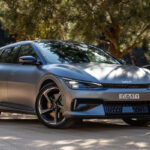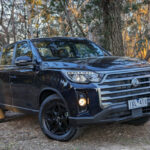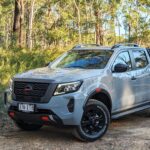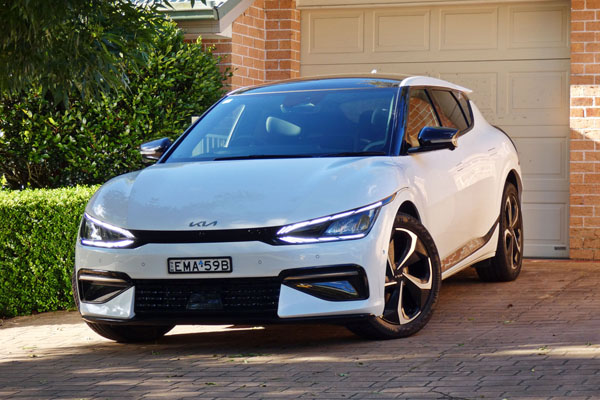
Back in the ’60s Gerry Anderson created the puppet phenomena Thunderbirds.
The puppets or marionettes later grew into real life actors in shows like UFO and
Space: 1999, complete with space-age clothing, architecture and futuristic cars that
made a buzzing, turbine-like sound.
I suspect many car designers have spent too much time watching sci-fi shows
because most seem to think EVs should come in a futuristic package, with form
taking precedence over functionality.
Kia’s first dedicated, fully electric vehicle, EV6, is an example. It looks and feels more
like a statement of what is possible rather than a real car, one ready to take on the
demands of the weekly grind or occasional trip to the tip on Saturday with a back full
of crap.
EV6 may be Wheels’ Car of the Year and there are certainly many things to like
about the car, but it’s not the most practical thing we’ve driven — not by a long shot.
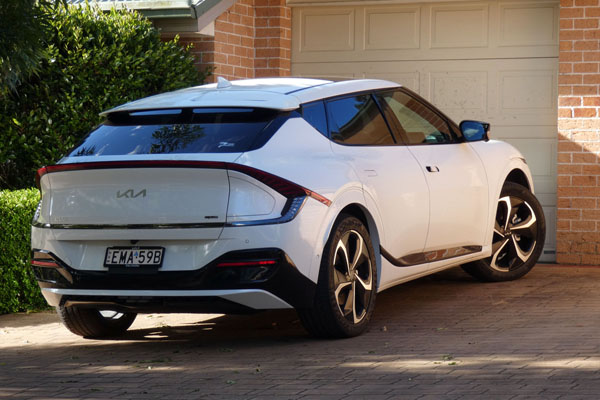
STYLING
It’s a long, wide car at almost 4.7 metres and 1.9 metres across, with an oh-so-long
2900mm wheelbase.
But the proportions are not what we have come to recognise as ideal, with a short
bonnet and hindquarters that bracket a long cabin.
After all, there’s no gas-guzzling ICE to accommodate up front. The batteries take up
a bit of space though, sandwiched and spread out under the floor. To placate
traditionalists, a grille of sorts remains at the front.
Unlock EV6 and flush-fitting, body-coloured door handles pop out in welcome.
Black A-pillar, wing mirrors and beltline garnishes complete the look, with full-width
tail lights and a stylish rear wing.
Prices start from $72,590 for the EV6 Air RWD. EV6 GT-Line RWD is priced from
$79,590, while top of the range EV6 GT-Line AWD is priced from $87,590.
A high-performance version, the 430kW EV6 GT, is expected in January around the
time of the Australian Open which Kia sponsors. Its price is yet to be revealed.
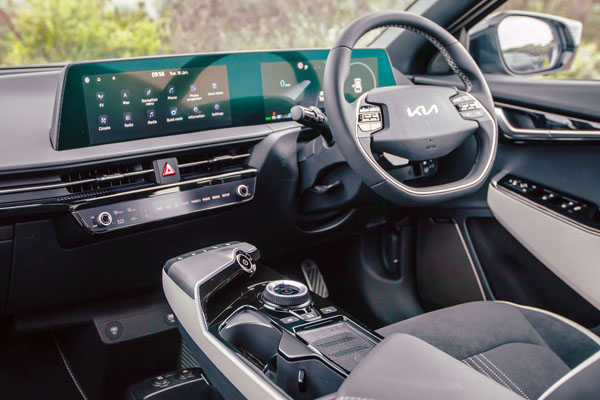
Our test vehicle, the GT-Line AWD, came with the options of premium paint ($520)
and a second cable that allows the car to be hooked up to a pay-as-you-go charger
($583), taking the price to $88,693 before on-road costs.
Standard kit includes 20-inch alloys with Continental 255/45 tyres, dual zone climate
air with rear vents, and power-adjust, heated and cooled front seats, a heated
steering wheel and mood lighting with 64 colours.
Trim is a combination of black and white, a mix of artificial suede and vegan leather
upholstery with white stitching, with power adjustment for driver lumbar support.
There’s also LED lights, folding, heated door mirrors with integrated indicators,
automatic high beam, smart cruise control with stop and go, auto parallel and
perpendicular parking, tilt and slide sunroof and a smart power tailgate.
Rounding out the list is head-up display, an auto-dimming rear-view mirror, auto
lights and wipers, front and rear parking sensors, along with a 360-degree camera.
Like all Kias, it’s covered by a 7-year unlimited kilometre warranty. Unlike others,
pre-paid service plans are available.
INFOTAINMENT
Infotainment consists of a 12.3-inch touchscreen, with built-in navigation, with
AM/FM and DAB+ digital radio, Bluetooth, together with wired Android Auto and
wired Apple CarPlay plus ‘Sounds of Nature’ ambient background noise.
In the GT-Line the standard six-speaker sound system makes way for Meridian
premium audio with 14 speakers.
Connect with three USB Chargers (1 x Type A and 2 x Type C) in the front tray with
multimedia connectivity, two USB Charger (Type C) in front seat backs, plus two 12-
volt power outlets ( 1 x boot side/1 x front tray). Wireless Qi phone charging is also
standard.
ENGINES / TRANSMISSIONS
Air is the more range focused of the trio, with 168kW of power and 350Nm of torque
and a range of 528km, while RWD GT-Line with the same powertrain is good for
504km.
GT-Line with AWD adds a second electric motor and produces a combined output of
239kW and 605Nm, along with a range of 484km.
All are powered by the same 77.4kWh battery pack, which is located under the floor
and weighs 477kg, with a single speed reduction gear transmission.
Moving through the grades, energy consumption ranges from 16.5 to 17.2 to 18.0
kWh/100km.
SAFETY
Five-star safety starts with seven airbags, a rear-view camera with dynamic
guidelines, plus Autonomous Emergency Braking (AEB) with car, pedestrian, cyclist
detection (and junction turn assist).
There’s also Blind Spot (including rear cross traffic assist), Intelligent Speed Limit
Assist (ISLA), Lane Follow Assist (LFA), Lane Keep Assist (LKA), Driver Attention
Warning with lead vehicle departure alert (DAW+), Multi-Collision Braking (MCB) and
Tyre Pressure Monitoring System (TPMS).
EV6 provides three top tether and two ISOFIX child seat anchors.
DRIVING
There are four selectable drive modes: Eco, Normal, Sport and Snow which also
change the look of the instruments.
Adding some drama to the drive experience is Active Sound Design (ASD) with a
choice of artificial engine sounds and custom setting.
They’re unique electronica rather than engine noise emulations.
With this much power and torque under foot and all that torque available in a flash,
EV6 has plenty of get up and go, with 0-100km/h in the AWD taking a rapid 5.2
seconds.
With a burst of speed, overtaking can be accomplished virtually at will, but it’s a
weighty device and wants to run wide in corners. Steering is heavy and
uncommunicative.
EV6 has powerful braking too, perhaps too strong at times, or more specifically —
irritatingly abrupt. It pulls up with a jerk and releases with a lurch, and can be difficult
to control in close manoeuvring.
One way to avoid this happening is one-pedal driving, using the regenerative brake
system that is controlled by the steering wheel paddles normally devoted to gears.
In this way, the car slows when you lift off the accelerator — to a complete stop if
necessary.
An electric parking brake is provided, but instead of being located close to hand in
the centre console, it’s relegated to a position to the right and below the dash.
More jerkiness follows. Try releasing the brake and moving off in reverse if you’re
parked on a slope. A dab on the accelerator pedal is required and is liable to result in
an intake of breath as the car shoots backwards.
EV6’s space-age look is polarising. Some people love it, others hate it.
Facing the wrong direction, the pop-out handles are awkward to use and for a 4.7
metre vehicle getting in and out is not as easy as it should be.
The door openings are large, but a low roofline and relatively high seating position
compromise access, together with the sunroof that further reduces headroom. Watch
your head and hold on to your sunglasses.
Ditto for rear seat passengers, with an elevated seating position and low hanging
roof, and surprisingly little legroom considering the length of the car.
Getting into the car for the first time I was confronted with a washed-out instrument
panel with pale blue lettering on a white background that was difficult to see in
sunlight.
I was later able to change this to black after finding the appropriate setting in the
infotainment system, but for the first few minutes I was flying blind.
Moving from one Kia to another, the steering wheel switch gear is familiar, but they
had been transposed from one side of the wheel to the other.
The dash layout is similar to that of the Niro EV that we drove, but as with Niro I
found that I had lost a physical volume control.
The luggage area is quite large with a hidden area underneath for cable storage,
along with a smaller boot at the front of the car, but alas no spare tyre.
A tyre repair kit is provided instead. Oh, and in case you’re wondering, it can tow a
1600kg load.
Most annoying was the location of the charge port. In Niro it is sensibly located at the
front, but in EV6 it is cleverly concealed near the driver side tail light. The location
necessitates backing the car in to access power.
Charging can take a looong time with a standard powerpoint, down to as little as 18
minutes for 80 per cent with a 350kW DC commercial charger.
Even fully charged the system reported a distance to empty range of 412km — some
70km less than claimed.
Stranger still, after travelling a few kilometres to do some shopping, the range
actually went up a few kilometres rather than down, even though the battery dropped
to 97 per cent.
At the end of the day, we were getting 17.0kWh/100km after about 400km of mixed
driving.
After all the EV6 hype, it’s a mixed bag and something of a let-down.
Until now Kia’s ergonomics have been a shining example of simplicity. Who let the
nerds out?
SUMMING UP
It’s a halo model for the brand, pure and simple. Cashed up nerds will want one.
Lesser so, user-choosers, who will be drawn to the usual line-up of Euro suspects.
Who then does that leave? It’s a fairly short, exclusive list at $90K by the time you
put it on the road.
Just over 500 EV6s have found homes in Australia this year. Over the same period,
Kia has sold four times as many Stingers (and they reckon its days are numbered).
No doubt, the arrival of the EV6 GT will give the figures a bit of a bump — but after
that, who knows?
RATINGS:
Looks: 7
Performance: 7.5
Safety: 8
Thirst: 7
Practicality: 6
Comfort: 7
Tech: 8
Value: 7
Overall: 7.2
AT A GLANCE
MODEL RANGE
EV6 Air RWD: $72,590
EV6 GT-Line RWD: $79,590
EV6 GT-Line AWD: $87,590
Note: These prices do not include government or dealer delivery charges. Contact
your local Kia dealer for drive-away prices.
SPECIFICATIONS (Kia EV6 GT-Line electric SUV)
POWERTRAIN:
Battery type: Lithium-ion
Battery Capacity: 77.4kWh
Configuration: Dual electric motors
Maximum Power: 239 kW
Maximum Torque: 605 Nm
Fuel Type: Electric
Energy consumption: 18.0 kWh/100km
Range: 484 km (WLTP)
CO2 Emissions: 0 g/km
DRIVELINE:
1 speed automatic transmission (Reduction Gear), AWD
DIMENSIONS, WEIGHT AND CAPACITIES:
Length: 4695 mm
Wheelbase: 2900 mm
Width: 1890 mm
Height: 1550 mm
Turning Circle: 11.6 metres
Kerb Mass: 2105 kg
BRAKES:
Front: 325 mm ventilated disc
Rear: 325 mm solid disc
STANDARD WARRANTY:
Seven years / Unlimited kilometres




